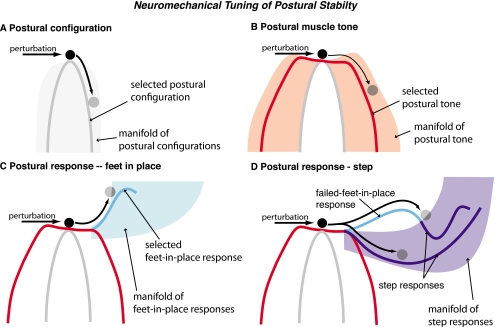Figure 1.
Conceptual framework for understanding tuning and coordination of neuromechanical elements contributing to postural stability. The intrinsic dynamics of the musculoskeletal system at the time of a perturbation depends upon the feedforward contributions of postural configuration and postural muscle tone, which are selected in advance by the nervous system. (a) The chosen postural configuration determines the basic skeletal mechanics of the body, which in standing balance control is unstable due to the divergence of the gravitational force field. Because of the redundancy of joints and limbs, there are many possible postural configurations that can be chosen during standing. (b) The selection of postural muscle tone during standing can also alter the stability of the body, as the instantaneous stiffness and viscosity of muscles vary as a function of their level of activation. Due to the redundancy of muscles across each joint, a large manifold of muscle activation patterns satisfies the static equilibrium requirements for maintaining the selected postural configuration and differs in the stability afforded to the body. Postural muscle tone may increase the time constant of instability of the body or provide a degree of local stability to very small perturbations. (c) When a perturbation to the body is sensed, directionally specific feedback postural responses are elicited, which alter muscle activity after a long delay. During the initial 150 ms following the onset of a perturbation, the dynamics of the body are determined by the intrinsic dynamics set by the feedforward neuromechanical elements in (a) and (b). Postural responses that allow the feet to remain in place have differential stabilizing capacities, which will depend upon the pattern and magnitude of muscle activation elicited. Generally, postural strategies that use primarily hip torques can generate larger restoring forces than those that rely on ankle torques due to limitations in maximum muscle force generation. (d) If the feet-in-place strategy is insufficient to stabilize the body, a step response that expands the base of support and generates a different fixed-point location can occur. Steps can vary in size and can also be elicited as the primary feedback response following a perturbation.

